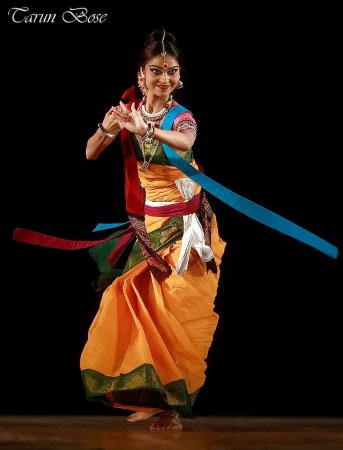
|
 |

|
 |
A hundred years of the call of dancing: the chimes continue - Dr Sruti Bandopadhay e-mail: srutibandopadhay@gmail.com March 4, 2020 The respectable Bengali families started appreciating dance as an art with the initiative of Rabindranath Tagore in Santiniketan. Rabindranath's exposure to one of the most lyrical dance styles of India, the Manipuri dance, in Tripura brought about a dance-renaissance in the Bengali society in the early 20th century. Though he first witnessed Manipuri dance in the Vasantotsava in Agartala in 1899, it took him almost 20 years i.e. 1919 to introduce the dance in his ashram in Santiniketan. This only establishes the fact that Manipuri dance as an art form had appealed to Rabindranath in such an intense manner in 1899 that even after 20 years, he felt the necessity for introduction of dance among his ashramites.  Shreya Mahata (Rabindranritya) during Vasantotsava in Santiniketan Interestingly, Manipuri dance evolved into its refined form with the ingress of Vaishnavism from Bengal. Vaishnava kirtana got its visual form in Manipur and its surrounds, where Manipuri people settled. One such area was Tripura, now in India and Sylhet, Kamalganj - now in Bangladesh. So what Rabindranath saw was the stories of Krishna elaborated through kirtanas, which were in the Bengali padavali language. Also the beautiful body language that gave a perfect visual to the bhakti while embodying these Bengali kirtanas. It is pertinent to point out here that the Manipuri society had dance woven in their societal pattern of life. Hence it was natural for them to imbibe kirtana songs as a complement to their body expressions. But in Bengal kirtana songs still exist as a vocal art. In 1919, Rabindranath witnessed Rakhal Ras in Machhimpur near Sylhet. On his request, the then royal family sent Sri Budhhimanta Singh for a very brief period to teach Manipuri in Santiniketan. This dance was initially taught to the boys in the name of rhythmic exercises. This may have been just a learning exercise at that time, but Rabindranath's act had a long impact in the dance scenario in Bengal. Kirtana that travelled from Bengal to Manipur journeyed back to Bengal through the medium of dance. Santiniketan became the space of learning. There happened many alterations. Firstly, the space in Santiniketan was absolutely secular, while spaces in Manipur at that time were completely ritualistic. Secondly, the dance was transferred into Bengali bodies, which were not prepared for dancing. Also features of a Manipuri body and a Bengali body varied vastly. Lastly, the Manipuri dance gestures were set into the lyrics of Rabindranath's song. This was the beginning of dance in middleclass Bengali society. But with time other dances also came to Santiniketan, which were used in dance compositions thereby bringing a unity of dances on Rabindranath's songs. Today we can claim that dancing on Rabindrasangit has become a tradition and Santiniketan is still continuing this practice. But with trained bodies in dance, the presentations have graduated and a distinction perceived.  Anwesha Bagchi (Rabindranritya) Today we stand at the centenary of introduction of Manipuri dance or rather dance in Santiniketan. In these hundred years, Rabindranath's dance idiom, Rabindranritya, stands as a well recognised form in the eastern part of India in which Manipuri dance plays the pivot. Bengali settlements all over the world sing and dance Rabindrasangit and produce his ever popular dance dramas. But we, at Santiniketan, hold more responsibilities because it is here that dance was introduced not for the purpose of just learning from Gurus and presenting those in its exact form, but to learn how to break the boundaries of a restricted pattern of movements for the purpose of visualization of Rabindranath's lyrics' significance. While doing so, his idea of dance aesthetics works as the centripetal force for Rabindranritya. Also costumes and sets designed during his time with creativity of stalwarts like Nandalal Bose, Surendranath Kar and others imprinted distinctiveness to this dance form. Any dance composition where concept of rabindrik sanskriti or Rabindranath's identity in presentation is not followed, the dance becomes only a presentation on Rabindrasangit and cannot be identified with Rabindranritya. To bring about a better understanding for the future generation dancers, Sangit Bhavana has introduced Rabindranritya as a core course in the graduate, undergraduate and at the MPhil, PhD level. Since the introduction of Manipuri hundred years back, Gurus initially from Tripura and later from Manipur had been continuously flowing in. Bengali boys and girls have also learnt and performed Manipuri dance and today we have almost uncountable alumni in our department. Manipuri and Bengali people in form of teachers and students exist simultaneously in Santiniketan - unity in culture persists. The initiative by the students, the present teachers and alumni to celebrate the occasion of the centenary year by personal donation of funds and not using any part of the budget allotted to Sangit Bhavana, is extremely admirable. It only puts forward the responsibility, the passion and the consciousness of the stake holders to value the historic fact. This festival is not only a celebration of dance remembering its introductory moment, but also a grateful move of respect for Rabindranath Tagore for whom we are learning, studying and researching dance at present. Prof. Dr Sruti Bandopadhay is a Professor in Manipuri Dance in Visva Bharati Santiniketan. She is the recipient of the Fulbright Fellowship, the Commonwealth Fellowship for teaching and performing in the US and the UK respectively. She is awarded the Dlitt in Manipuri Dance from Visva Bharati. She regularly performs, lectures and writes. She has 5 books and many articles on dance to her credit. Response * Excellent write up. - Mou Chakraborty (Nov 28, 2022) Post your comments Please provide your name and email id when you use the Anonymous profile in the blog to post a comment. All appropriate comments posted with name & email id in the blog will also be featured in the site. |